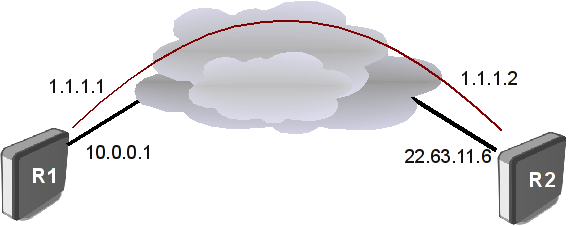The IPIP tunneling implementation on the MikroTik RouterOS is RFC 2003 compliant. IPIP tunnel is a simple protocol that encapsulates IP packets in IP to make a tunnel between two routers. The IPIP tunnel interface appears as an interface under the interface list. Many routers, including Cisco and Linux based, support this protocol. This protocol makes multiple network schemes possible.
IP tunneling protocol adds the following possibilities to a network setups:
IP tunneling protocol adds the following possibilities to a network setups:
- to tunnel Intranets over the Internet
- to use it instead of source routing
Properties
| Property | Description |
|---|---|
| local-address (IP; Default: ) | IP address on a router that will be used by IPIP tunnel |
| mtu (integer; Default: 1500) | Layer3 Maximum transmission unit |
| name (string; Default: ) | Interface name |
| remote-address (IP; Default: ) | IP address of remote end of IPIP tunnel |
Note: There is no authentication or 'state' for this interface. The bandwidth usage of the interface may be monitored with the monitor feature from the interface menu.
IPv6
Sub-menu:
/interface ipipv6IP/IPv6 over IPv6 tunnel functionality is added in v5RC6 and is configurable from another menu:
/interface ipipv6IPv6 version uses the same properties as IPv4 version.Setup examples
Suppose we want to add an IPIP tunnel between routers R1 and R2:
At first, we need to configure IPIP interfaces and then add IP addresses to them.
The configuration for router R1 is as follows:
The configuration for router R1 is as follows:
[admin@MikroTik] interface ipip> add local-address: 10.0.0.1 remote-address: 22.63.11.6 [admin@MikroTik] interface ipip> print Flags: X - disabled, R - running # NAME MTU LOCAL-ADDRESS REMOTE-ADDRESS 0 X ipip1 1480 10.0.0.1 22.63.11.6 [admin@MikroTik] interface ipip> en 0 [admin@MikroTik] interface ipip> /ip address add address=1.1.1.1/24 interface=ipip1
The configuration of the R2 is shown below:
[admin@MikroTik] interface ipip> add local-address=22.63.11.6 remote-address=10. 0.0.1 [admin@MikroTik] interface ipip> print Flags: X - disabled, R - running # NAME MTU LOCAL-ADDRESS REMOTE-ADDRESS 0 X ipip1 1480 22.63.11.6 10.0.0.1 [admin@MikroTik] interface ipip> enable 0 [admin@MikroTik] interface ipip> /ip address add address=1.1.1.2/24 interface=ipip1
Now both routers can ping each other:
[admin@MikroTik] interface ipip> /ping 1.1.1.2 1.1.1.2 64 byte ping: ttl=64 time=24 ms 1.1.1.2 64 byte ping: ttl=64 time=19 ms 1.1.1.2 64 byte ping: ttl=64 time=20 ms 3 packets transmitted, 3 packets received, 0% packet loss round-trip min/avg/max = 19/21.0/24 ms [admin@MikroTik] interface ipip>
Regards
Merah Putih Segoroasat
Thanks

Tidak ada komentar :
Posting Komentar